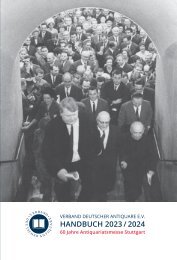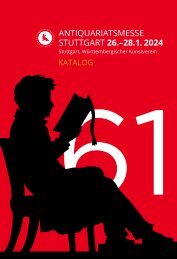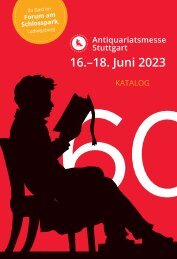Antiquariatsmesse Stuttgart 2022 - Katalog
Katalog zur Antiquariatsmesse Stuttgart 2022: Die diesjährige Antiquariatsmesse Stuttgart, Deutschlands bedeutendste Messe für schöne und seltene Bücher, Autographen, illustrierte Werke und Graphik findet, wie bereits im vergangenen Jahr pandemiebedingt nicht als klassische Messe, sondern in Form des gedruckten Kataloges und als digitale Messe auf bewährter Plattform (18. bis 22. Februar 2022) statt. 73 Antiquariate und Galerien aus Deutschland, Österreich und der Schweiz, den Niederlanden, Frankreich, England und den USA werden auch in diesem Jahr die gesamte Bandbreite des Antiquariatshandels präsentieren. Der gedruckte Katalog wird ab dem 31. Januar 2022 an interessierte Kunden verschickt, die virtuelle Messe öffnet ihre „digitalen Pforten“ am 18. Februar 2022 um 12.00 Uhr unter www.antiquariatsmesse-stuttgart.de
Katalog zur Antiquariatsmesse Stuttgart 2022: Die diesjährige Antiquariatsmesse Stuttgart, Deutschlands bedeutendste Messe für schöne und seltene Bücher, Autographen, illustrierte Werke und Graphik findet, wie bereits im vergangenen Jahr pandemiebedingt nicht als klassische Messe, sondern in Form des gedruckten Kataloges und als digitale Messe auf bewährter Plattform (18. bis 22. Februar 2022) statt.
73 Antiquariate und Galerien aus Deutschland, Österreich und der Schweiz, den Niederlanden, Frankreich, England und den USA werden auch in diesem Jahr die gesamte Bandbreite des Antiquariatshandels präsentieren.
Der gedruckte Katalog wird ab dem 31. Januar 2022 an interessierte Kunden verschickt, die virtuelle Messe öffnet ihre „digitalen Pforten“ am 18. Februar 2022 um 12.00 Uhr unter www.antiquariatsmesse-stuttgart.de
Erfolgreiche ePaper selbst erstellen
Machen Sie aus Ihren PDF Publikationen ein blätterbares Flipbook mit unserer einzigartigen Google optimierten e-Paper Software.
work on Infusiora. “Ehrenberg’s great contribution<br />
to biology was his work on the infusiora, the results<br />
of which were published originally in a number of<br />
brief essays and afterwards in the important and splendid<br />
work entitled ‘Die Infusionsthierchen’ printed in<br />
1838. The result of this and other works of his was<br />
that the number of known Infusiora was considerably<br />
increased, and their classification essentially advanced”<br />
(Nordenskiöld p. 427). The excellent plates are all after<br />
Ehrenberg’s own drawings. After his death in 1876, his<br />
collections of microscopic organisms were deposited<br />
in the Museum für Naturkunde at the University of<br />
Berlin. The “Ehrenberg Collection” includes 40.000<br />
microscope preparations, 5.000 raw samples, 3.000<br />
pencil and ink drawings, and nearly 1.000 letters of<br />
correspondence. Some occasional foxing in the text<br />
volume, not in the atlas volume. Stamps on title-pages.<br />
Provenance: Name of Eschricht 1849, probably Daniel<br />
Frederik Eschricht, Danish zoologist, on free endpaper<br />
and an old stamp of H. Adolph Meyer on title. – Garrison<br />
& Morton 111; Nissen ZBI, 1244.<br />
Jacquin, J. F. (Baron von). Beyträge zur Geschichte<br />
der Vögel. Wien, C. F. Wappler, 1784. 4to (285 × 230<br />
mm). pp. (10), 45, (1), with 19 handcoloured engraved<br />
plates. 19th century cloth-backed marbled<br />
boards (spine a bit worn). € 4500,–<br />
An important work as it gives early descriptions of<br />
birds from the West Indies and the northern parts of<br />
South America. Emperor Franz Stephan, husband of<br />
Maria Theresia, founded the Imperial Zoological Gardens<br />
at the Schönbrunn Palace in 1752. In 1755 he sent<br />
an expedition to the West Indies and the northern parts<br />
of South America to collect plants and animals for the<br />
gardens at Schönbrunn and the menagerie. Nicolaus<br />
Joseph Jacquin was in charge of the expedition which<br />
lasted 4 years. During this trip he made notes on birds<br />
which were published by his son Joseph Franz Jacquin.<br />
32 species are treated of which 25 come from the above<br />
mentioned regions. According to the descriptions in the<br />
book almost all the birds had been kept at the Schönbrunn<br />
menagerie. “Several new species are described.<br />
The plates are excellent for the period” (Zimmer I, 320).<br />
Only 2 plates are signed by the artist, one plate by A.<br />
Amon and one plate by J. Adam. – Anker 220.<br />
Sie sind vom Sohne des Verfassers, A. Lunel, gemalt<br />
und von dem Genfer Lithographen Jacomme in vorbildlicher<br />
Weise wiedergegeben …” (Nissen, Schöne<br />
Fischbücher p. 29). Godefroy Lunel (1814–1891) was<br />
the first director of the “Museum d’Histoire Naturelle<br />
de Genève”. A well preserved copy of this rare work.<br />
– Nissen, Schöne Fischbücher 90; B. M. (N. H.) III,<br />
1195; Dean II, 71.<br />
Mayer, J. P. Pomona Franconica oder natürliche<br />
Abbildung und Beschreibung der besten und vorzüglichen<br />
Europäischen Gattungen der Obstbäume<br />
und Früchte welche in dem Hochfürstlichen Hofgarten<br />
zu Würzburg gezogen werden. Nebst den<br />
haupsächlichsten Anmerkungen über deren Erziehung,<br />
Propfung und Pflege … Pomona Franconica.<br />
Description des Arbres fruitiers, les plus connus et<br />
les plus estimés en Europe … Nürnberg, bey Adam<br />
Wolfgang Winterschmidt, 1776–1779. 2 volumes.<br />
4to (245 × 200 mm). pp. civ, 152; (4), 364, with engraved<br />
frontispiece, 1 folded engraved garden plan,<br />
10 engravings in the text and 110 engraved plates of<br />
which 99 spendidly handcoloured. Contemporary<br />
half calf, spines in 6 compartments with gilt ornaments<br />
and gilt lettered red and green labels (tiny old<br />
repair to top of one volume and foot of the other<br />
one). € 18 000,–<br />
A very fine copy of the most attractive work on fruit<br />
published in Germany. “Der Hochfürstliche Hof- und<br />
Residenzgärtner Johann Mayer verfasste das bedeutende<br />
Werk ‘Pomona Franconica …’ Im ersten Band<br />
sind 12 Aprikosen-, 6 Mandel- und 33 Pflaumensorten<br />
enthalten, im zweiten 25 Kirschen- und 32 Pfirsichsorten<br />
…” (Martini p. 70). “A delightful and charming<br />
work” (Dunthorne). “Johann Mayer was born in<br />
Prague and learned about gardening in France and<br />
Lunel, G. Histoire naturelle des Poissons du Bassin<br />
du Léman. Genève, H. Georg, 1874. Large-folio<br />
(495 × 330 mm). pp. (4), xii, 209, (3), with 20<br />
chromolithographic plates. Contemporary red half<br />
morocco, spine with gilt lines, frontcover with gilt<br />
lettering of the title. € 4600,–<br />
First and only edition of this splendidly produced<br />
work on fishes. 120 copies were printed of which<br />
only 20 were put for sale. Together with J. L. Agassiz’s<br />
“Histoire naturelle des poissons d’eau douce de<br />
l’Europe central” the most beautiful Swiss book on<br />
fishes. The plates are very attractive as many have been<br />
printed with silver and gold colours. “Ähnlich naturgetreue<br />
Bilder, deren Farben mit wahrer Leidenschaft<br />
dem Leben abgerungen sind, finden sich in der ‘Histoire<br />
naturelle des poissons …’ von Godefroy Lunel.<br />
95






